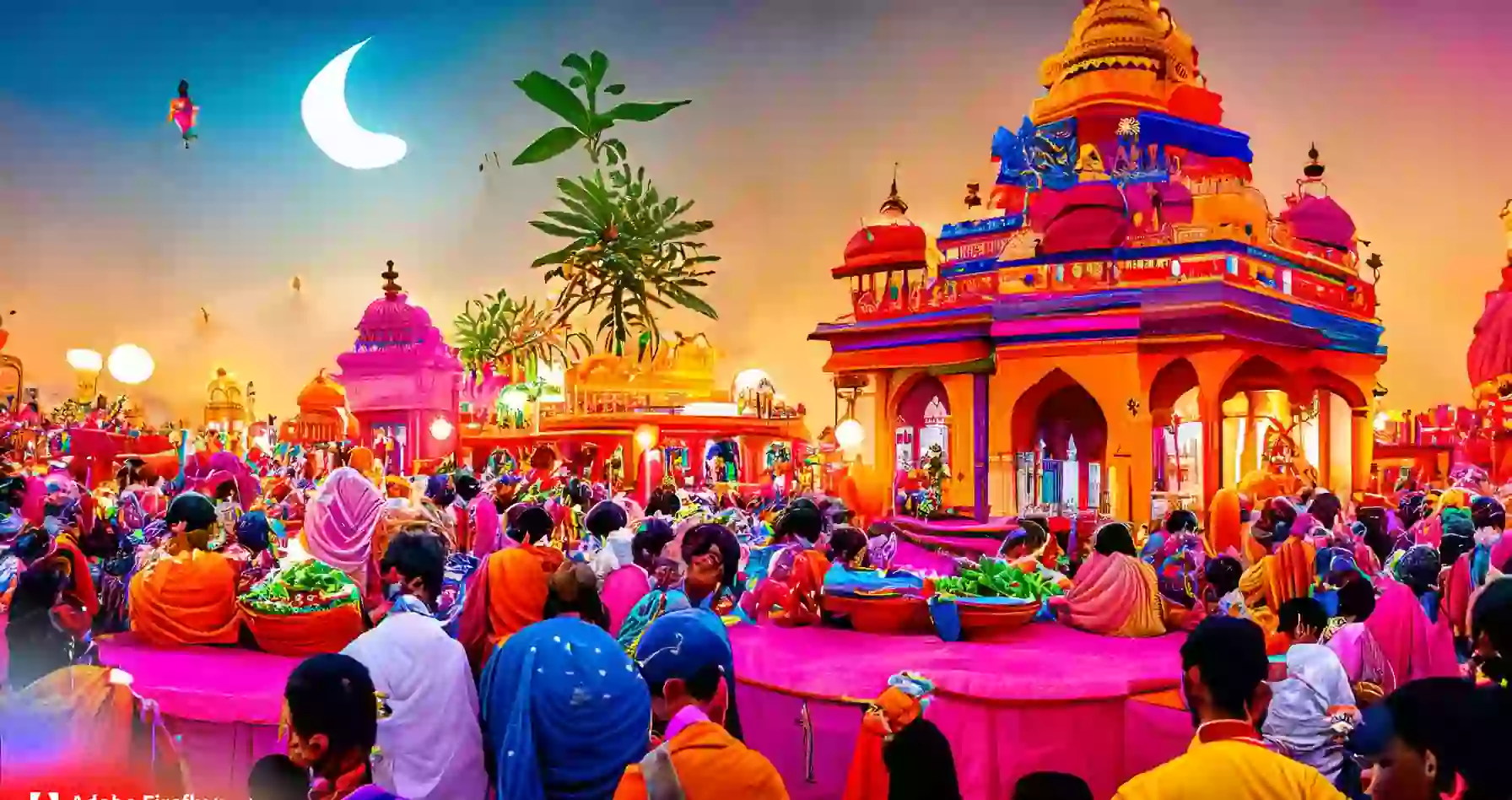India is a country known for its rich cultural heritage, which is deeply intertwined with religion. The country is home to a wide range of religious traditions, including Hinduism, Buddhism, Islam, Sikhism, Jainism, and Christianity. These religions have played a significant role in shaping Indian society, culture, art, and literature. In this article, we will explore the impact of different religions on Indian traditions and how they continue to influence contemporary society.
How Religions Influence Indian Traditions?
Religion has historically influenced Indian society on a political, cultural, and economic level. India is home to a wide range of religious traditions, and the blend of beliefs held by its people is evident in the customs and traditions of the country1.
Although the specific practices and beliefs of different religions may vary, all of India’s major religious communities are highly observant by standard measures.
Here are some ways in which different religions influence Indian traditions:
- Marriage and Conversion: Marriages across religious lines and religious conversions are exceedingly rare in India, and many Indians across different religious groups say it is very important to stop people in their community from marrying into other religious groups2.
- Festivals and Rituals: Many festivals and rituals in India are based on Hindu and Buddhist mythology and beliefs, such as Diwali, Holi, and the Kumbh Mela. There are also many festivals celebrated throughout the country dedicated to the many Hindu narratives and deities3.
- Social Structure: Hinduism’s faith has had a profound impact on the customs and traditions of India, shaping its culture and society. The Hindu caste system, which assigns people to specific social groups based on birth, is one of the most visible aspects of religious influence. Followers of India’s religions, particularly Hindus and Muslims, have created what Indians call “communities,” groups who largely coexist peacefully but live and worship in separate social circles.
- Beliefs: Hindus who hold a favorable view of the Bharatiya Janata Party (BJP) are more likely than other Hindus to say they believe in reincarnation, karma, and the purifying power of the Ganges1. Muslims are just as likely as Hindus to believe in the concept of reincarnation. The influence of Hinduism and Buddhism has also seen the rise of religious tolerance, acceptance, and respect for different faiths and beliefs.
What are the major religions that have influenced Indian traditions?
Hinduism
Hinduism is the oldest and most influential religion in India, dating back over 4,000 years. The vast collection of scriptures, rituals, beliefs, and traditions that make up Hinduism have had an enormous impact on nearly every aspect of Indian culture. Core Hindu concepts like karma, dharma, reincarnation, meditation, and the worship of deities continue to shape the worldview of most Indians today.
Islam
Islam arrived in India in the 7th century CE and has exerted a profound influence on Indian religion, architecture, music, cuisine, traditions, and more. Islam expanded greatly under the Mughal Empire in the 16th-18th centuries, giving rise to brilliant architectural monuments like the Taj Mahal. Today, Islam is the second largest religion in India after Hinduism.
Buddhism
Buddhism originated in India around 500 BCE through the teachings of Gautama Buddha. Although Buddhism declined on the Indian subcontinent by the 12th century, its influences on philosophy, art, literature and culture continued. Buddhist concepts like non-violence, compassion and mindfulness meditation remain relevant in India today.
Sikhism
Sikhism emerged in the Punjab region in the 15th century CE, preaching a message of one God, equality, and service to humanity. Sikhism played a key role in shaping Punjabi culture and history. Sikh temples, poetry, music, and scriptures continue to be important cultural markers, while Sikh philosophy emphasizes selfless service.
Jainism
Jainism, born in India over 2,500 years ago, emphasizes non-violence, asceticism and compassion. Jain precepts of vegetarianism, fasting and meditation have significantly influenced Indian art, literature, philosophy and culture, while its temples and institutions uphold ancient traditions.
Christianity
Christianity arrived in India with European colonists and missionaries in the 16th century. Indian Christians have made unique contributions to philosophy, literature, education, arts and culture. Christian influences can be seen in architecture, music, literature, education and social reform movements.
How has Hinduism impacted Indian society and culture?
Hinduism has profoundly shaped nearly every aspect of Indian culture and society over thousands of years. Here are some major ways Hinduism has impacted Indian life:
- Social structure – The Hindu caste system has long structured social classes and strong ideas about duties, roles and appropriate behavior for each group.
- Art & Architecture – Ancient Hindu temples, sculptures and paintings established distinct Indian styles seen in art today. Temples remain active cultural hubs.
- Literature – India’s incredibly rich literary heritage draws heavily on Hindu scriptures and epics like the Vedas, Ramayana and Mahabharata for themes and philosophy.
- Music & Dance – Sacred Hindu hymns and chants inspired classical Indian musical styles and dances expressing Hindu stories through mudras and costumes.
- Cuisine – Vegetarianism, ideals of purity and fasting rituals inherent in Hindu diet restrictions have shaped food culture.
- Family structure – Traditional Hindu views on marriage, gender roles and the joint family system continue to influence Indian family values today.
- Holidays & Festivals – Important Hindu holidays like Diwali, Holi and Durga Puja are celebrated by all Indians regardless of religion.
- Politics – Hindu nationalism has risen as a major political force in modern India. Political parties evoke Hindu symbols and ideas.
- Philosophy – Concepts like karma, dharma, non-violence, reincarnation and paths to enlightenment form the basis for much of Indian philosophy.
- Language & Literature – The prominence of Sanskrit and the Hindi belt has linguistic roots in Hindu traditions. Epics like the Ramayana and Mahabharata remain popular.
- Spirituality – Yoga, meditation, gurus and ashrams are central to both Hinduism and Indian spirituality today.
In short, core Hindu beliefs have molded Indian identity and infused themselves into everyday Indian life over millennia.
What is the caste system in India, and how is it related to religion?
The caste system is a hierarchical social structure which divides Hindus into occupational groups based on notions of ritual purity and pollution. It has ancient origins in Hindu scriptures and law.
At the top are the Brahmin priests and scholars, followed by the Kshatriya warriors and rulers. Next are the Vaishya merchants and landowners, and finally the Shudras who are largely peasants and laborers. Outside the system are the Dalits who were historically called “untouchables” due to the belief that they pollute higher castes.
This stratified social system derives legitimacy from Hindu religious texts which outline varna categories and the ideal dharma or duties of each caste. The Rig Veda contains the oldest mention of the varna system while later scriptures like Manusmriti extensively codified caste distinctions and restrictions.
Ideas of karma, rebirth and ritual purity underpin the caste system. Caste groups historically practiced endogamy to maintain purity and social standing. Violations of caste rules were punished and seen as polluting.
While legal discrimination and “untouchability” have been abolished, aspects of caste prejudice persist, particularly in rural areas. Quota systems now promote greater representation of lower castes. The influence of caste on social life, occupations and marriage remains quite strong, despite modernization.
How has Buddhism influenced Indian literature and art?
Buddhism has made significant contributions to Indian literature and art over the centuries:
- Buddhist scriptures like the Tripitaka Canon serve as early examples of Indian writing documenting Buddhist philosophy, discourses and monastic rules.
- Ancient Buddhist poetry by monks like Ashvaghosa in 1st century CE Sanskrit epics reveal key metaphysical ideas and moral teachings.
- Jataka tales – stories of Buddha’s past lives – have inspired plays, dance, films, art and moral fables since ancient times.
- Buddhist influences introduced Greco-Buddhist art styles evident in early Indian temple sculptures and architecture.
- Chaityas – Buddhist cave temple sites – at places like Ajanta and Ellora feature exquisite stone carvings depicting the Buddha’s life and other faith elements.
- Stupa shrines housing relics began displaying ornate decoration. The Ashokan stupas are exemplary.
- Monasteries often had prayer halls adorned with paintings of Buddha’s life, themed murals and other sacred imagery in a distinct Buddhist iconography.
- Pali and other Prakrits became prominent literary languages employed alongside Sanskrit to convey Buddhist themes to common people through poetry, tales and dramas.
- Modern Indian writers like A.K. Ramanujan, Govind Chandra Pande and Abhay Kumar have composed contemplative poetry inspired by Buddhist wisdom.
- Contemporary Indian artists such as Jogen Chowdhury and Manjit Bawa incorporate Buddhist visual motifs and philosophies in their paintings.
So from ancient times to today, Buddhism left a unique stamp on Indian literary, visual and performance arts conveying spiritual ideas and human virtues.
What is the significance of Sikhism in Indian history and culture?
Sikhism emerged in the Punjab region of India in the 15th century CE under the teachings of Guru Nanak Dev. As a faith, culture and community, Sikhism has made profound contributions to Indian history and society:
- Religious significance – Sikhism preached a message of one God, devotion, equality, service and honest living. This appealed to many Indians disillusioned by caste and rituals.
- Cultural impact – Sikhism developed distinctive symbols like the kada bracelet and five Ks, unique music forms like shabad kirtan, and the Punjabi language flourished.
- Political influence – Sikh gurus challenged the Mughal Empire. Later, Ranjit Singh established a powerful Sikh kingdom that resisted British annexation.
- Military legacy – Sikhs have a long martial tradition. They formed the backbone of British Indian army regiments due to their valor and loyalty.
- Philosophy – Sikh scriptures and tenets espouse progressive social ideals such as gender equality,rejecting superstitions, dignifying labor, serving humanity, etc.
- Literature – The Guru Granth Sahib is a uniquely eclectic scripture blending poetic hymns of Sikh gurus with saints from different religions.
- Independence movement – Some prominent Sikh freedom fighters were Bhagat Singh, Sukhdev, Udham Singh, and the Akali movement.
- Community impact – The Khalsa traditions forged a strong collective Sikh identity and sense of service to humanity. Sikh langars uphold inclusivity.
- Global presence – Migration spread Sikh communities worldwide where gurdwaras keep traditions alive. Sikhs are seen as hardworking and principled people.
In summary, Sikhism significantly shaped religion, society, politics and culture in North India and the wider world beyond. Sikhs represent an iconic Indian community recognized globally for identity, values and achievements.
How has Jainism influenced Indian customs and traditions?
Jainism is an ancient Indian religion that has significantly impacted Indian culture and customs:
- Vegetarianism – Jain precepts of non-violence and compassion have strongly promoted vegetarianism, influencing Indian food habits.
- Fasting – Regular fasting, especially during holy periods like Paryushana, is an important Jain custom now common in Hindu and other Indian communities.
- Animal welfare – Jain opposition to animal slaughter led to widespread animal shelters or ‘pinjrapoles’ run by Jain volunteers.
- Self-discipline – Jain monks and nuns adopt asceticism, practising strict self-control and renunciation, inspiring similar disciplines in other faiths.
- Non-violence – The philosophy of ahinsa or non-injury has been the basis of India’s modern non-violence movements led by Gandhi and others.
- Forgiveness – Jain teachings strongly advocate forgiveness and letting go of resentment, influencing traditions promoting reconciliation.
- Charity – Donations to religious and social welfare institutions is an esteemed Jain tradition now integral to Indian philanthropy.
- Purity of conduct – Jain codes of ethics govern appropriate behaviour for laypeople and ascetics, shaping general moral conduct in society.
- Temples – Jain temples, libraries and cultural centres have preserving ancient manuscript collections and artistic heritage.
- Literature & education – Jain versions of folk tales and fables have enriched Indian storytelling traditions while emphasizing literacy and learning.
Jainism’s lasting contributions to ethics, vegetarian cuisine, animal rights and non-violence affirm its major role in shaping Indian customs and values.
What is the impact of Islam on Indian society and culture?
Islam’s arrival in India from the 8th century CE led to a profound cultural exchange and synthesis:
- Architecture – Islamic architectural wonders like the Taj Mahal and Jama Masjid exemplify the magnificent Indo-Islamic style, dotting India’s landscape today.
- Language – Urdu, Hindi, Bengali etc. absorbed Arabic, Persian words and the Nastaliq script, enriching Indian literary heritage.
- Music – Islamic musical instruments like tabla, sitar and santoor merged with Indian ragas to produce enduring forms like Sufi qawwali.
- Cuisine – Mughlai dishes reflecting Central Asian and Middle Eastern influences became extremely popular, integral to Indian cuisine today.
- Clothing – Garments like the salwar kameez, sherwani, and fez cap were introduced or influenced by Islamic styles.
- Education – Muslim rulers established educational institutions. Aligarh Muslim University remains highly reputed today. Madrasas teach Islamic scriptures and law.
- Administration – Islamic political ideas influenced administrative systems establishing land revenue, taxation and military organization.
- Commerce- Arabian horses, fruits and herbs were brought via trade networks. Family businesses among Muslim merchant communities drove investment.
- secularism – Muslim rulers like Akbar championed religious tolerance and pluralism to govern India’s diversity. Composite culture thrived.
- Social reform – Muslim scholars like Sir Syed Ahmed Khan advocated for girls’ education, widow remarriage, and abolishing superstitions.
- Literature – Muslim poets and scholars enriched Indian literature greatly. Urdu poetry flourished with iconic poets like Ghalib.
Islam left an indelible imprint on Indian culture, customs, architecture, language, food, music and attire, reflecting a profound confluence between Hindu and Islamic civilizations.
How has Christianity influenced Indian literature and art?
Christianity’s arrival in India through colonialism and missionaries led to unique artistic and literary expressions:
- Bible translations into Indian languages familiarized local vocabularies with Christian stories and ideas.
- Indian writers began retelling and contextualizing Biblical stories in Indian social settings through novels, short stories, poems and plays.
- Christian influences can be seen in the realist novels of Indian writers like R.K. Narayan and Mulk Raj Anand exploring social issues.
- Works of Indian English poets like Nissim Ezekiel, A.K. Ramanujan, and Kamala Das explore Christian imagery and themes like redemption.
- Autobiographies by early converts like Dalit writer Bama relate their struggles and identity reconciling Christianity with Hindu oppression.
- Kerala’s Christian theatrical tradition resulted in Biblical plays and choreographed choral singing tales based on saints’ lives.
- Ivory carvings of Biblical figurines were produced by Goan and South Indian craftsmen, often incorporating local design motifs.
- Catholic shrines dedicated to Virgin Mary in places like Velankanni incorporate Indian architectural styles and are popular pilgrimage sites.
- Indian Christian artists might employ Christian iconography or invoke themes like the Passion of Christ through a distinctly Indian visual interpretation.
- Gospel music, hymns and Christmas carols set to Indian tunes and instruments form a branch of Indian choral singing.
While a religious minority, the Christian community contributed new literary genres, art forms and musical styles to India’s composite heritage.
What are some examples of how religion has shaped Indian music?
Religion has profoundly influenced the diverse musical landscape of India:
- Bhajans – Devotional Hindu temple songs dedicated to deities, composed by saints like Surdas and Tulsidas using ragas and tala cycles.
- Qawwali – Ecstatic Muslim devotional genre performed at Sufi shrines praising saints and incorporating themes of divine love.
- Gurbani Kirtan – Sikh hymns from the Guru Granth Sahib sung traditionally in gurdwaras to classical ragas.
- Carnatic Krithis – South Indian devotional songs by composer-saints like Purandara Dasa in praise of Hindu gods set to classical ragas.
- Christmas Carols – Christmas hymns celebrating Christ’s birth have been composed in Indian languages set to regional folk tunes.
- Temple Music – Musical rituals and processional drumming integral to Hindu temples, their unique percussive patterns calling deities.
- Islamic Call to Prayer – The soulful Arabic Azan recited in mosques has a quintessentially Indian flavor and styles varying regionally.
- Buddhist Chants – From Tibetan mantra recitations to Pali sutra chanting, Buddhist traditions have incorporated melody and rhythm.
- Jain Bhajans – Hymns sung in Jain temples to Tirthankaras and Jain nuns such as the accomplished poet-saint Shree Aruniyamba.
- Folk Traditions – Devotional themes celebrating local gods/goddesses and saints permeate diverse regional folk music and dance forms.
- Filmi Sangeet – Indian cinema music has frequently incorporated religious lyrics, themes, and artists playing on religiosity.
Religious beliefs have been expressed aesthetically in India through sacred words and song as peaceful, joyous and transcendent musical offerings to the divine.
How has religion influenced Indian architecture?
Religion has deeply impacted architecture across India’s landscape:
- Hindu Temples – Ancient Indian styles like Nagara evolved for Hindu temples to tower over shrines as symbolic sacred mounts and hold carved depictions of gods.
- Buddhist Monasteries – Monasteries contained shrines in chaitya-griha prayer halls surrounded by pillars, stupas, rock-cut viharas and meditation cells.
- Jain Temples – Elaborate marble Jain temples and cave shrines were adorned with intricate decorative carvings depicting Tirthankaras.
- Churches – From Syrian churches in Kerala to Goan cathedrals, Christian architecture displays an Indo-European fusion of domes, stained glass and Gothic elements.
- Mosques – Islamic architecture saw magnificent Indo-Islamic mosques built across India culminating in the iconic Taj Mahal mausoleum.
- Gurdwaras – Sikh shrines evolved the darbar Sahib assembly hall to house the holy scripture, bounded by decorated gateway entrances.
- Stupas – Massive hemispherical Buddhist relic mounds with decorative gateways evolved across Asia from Indian prototypes.
- Dargahs – Sufi shrines housing saints’ tombs developed a unique architecture of sandstone, jalis, minarets and carved mother-of-pearl.
- Cave Complexes – Sacred caves at Ajanta and Ellora housing carved temples, monasteries and shrines exemplify an iconic rock-cut style.
- Temple Tanks – Large ritual bathing pools, steps and pavilions became fixtures of South Indian Hindu temples.
In myriad structural forms for various rites, religion inspired ingenious Indian architectural achievements.
What is the role of religion in Indian politics?
Religion exerts an enormous influence on Indian politics and governance in many ways:
- Political parties and voting blocs are frequently organized along religious lines like the Hindu nationalist BJP or Muslim League. Leaders rely on religious affiliations to mobilize voters.
- Communalism and ugly identity politics thrive, with politicians evoking religious symbols and prejudices against minorities for political gain.
- Fundamentalist religious lobbies like right-wing Hindu groups push a religious agenda through public policies, censorship, rewriting history etc, often distorting secularism.
- Leaders make rhetorical speeches invoking religious ideals of justice, morality or script
- Leaders make rhetorical speeches invoking religious ideals of justice, morality or scripture to sanctify their political agenda and present themselves as fulfilling some religious destiny.
- Political disputes frequently involve religious sites and community rights to places of worship, igniting tensions between faiths.
- Laws, court rulings and state policies regarding marriage, education or social issues often get mired in religious concerns, like uniform civil code, conversion or language policies.
- The nexus between religious leaders, places of worship and politicians results in faith becoming an electoral strategy for garnering votes.
- Coalition politics means government policies and positions require balancing religious interests, risking a weak pragmatic secularism vulnerable to fundamentalists.
- Religion inspires many activists, NGOs and civil society groups to advocate for social justice, human rights and environmental protection.
- Caste affiliations stemming from Hinduism play a major role in electoral and vote bank politics especially at local levels.
- While the Constitution upholds secularism, religion continues to assert a very powerful influence on partisan politics and public policies in India.
What is the relationship between religion and language in India?
Religion has profoundly influenced the linguistic landscape of India:
- Sanskrit derives from the Vedic language of Hinduism’s foundational texts, lending Hinduism an authoritative medium for scripture and ritual.
- Classical Hindi and vernaculars like Braj Bhasha developed from Sanskrit to convey Hindu religious themes through poetry and songs.
- Pali and Ardhamagadhi served as early linguistic mediums for transmitting Buddhist and Jain philosophies in a vernacular style.
- Sikh scripture was compiled in Gurmukhi script by the Sikh Gurus to be accessible to all. Gurmukhi remains closely tied to Sikh religious identity.
- Urdu assimilated words from Arabic and Persian to convey Islamic ideas. Muslim preachers and Sufi poets enriched Urdu with mystical expressions.
- Christian missionaries pioneered translations of the Bible into many Indian languages, introducing communities to Christian concepts.
- Languages adopted loan words from religious terminology e.g. karma, moksha, mantra, puja, seva, kalma, khuda.
- Preachers have reached the masses by transmitting faith through folk tales, songs, plays and discourses in regional languages.
- India’s language politics have been shaped by the interests of religious communities e.g. Hindi for Hindu nationalists, Urdu for Muslims.
- Caste discrimination has been challenged by rendering sacred texts into Dalit languages like Tamil or Malayalam.
Religion has sculpted the very structure of languages while languages have shaped the expression of faiths in the Indian subcontinent.
How has religion influenced Indian fashion?
Religious traditions have significantly shaped Indian clothing and fashion:
- Sari styles to cover head and shoulders arose from Hindu norms of modesty. Bindi, bangles and toe rings hold religious-cultural significance.
- Salwar kameez suits adapted Central Asian Islamic styles to local preferences of modesty and breathability.
- The Sikh turban signifies piety and self-respect. Styles vary for men and women. Keski headscarves are worn by Sikh women.
- Skull caps, sherwanis, Achkan jackets and Fez caps display the impact of Islamic culture on male attire.
- Dhoti or veshti as lower garment are popularized from ancient Hindu fashion, used in temples, Kerala and Tamil Nadu.
- Buddhist monks wear saffron or maroon robes following ancient traditions, while nuns don white, pink or red.
- Hindu and Jain nuns adopt simple, ascetic white clothing reflecting vows of renunciation.
- Brightly colored and richly embroidered fabrics are used for festivals and weddings deriving from Hindu rituals and aesthetics.
- Traditional Catholic women in Goa and South India wear long gowns and veiled mantilla lace head covers during church rituals.
- Muslim women often wear burqa and abaya out of religious modesty. Hijab styles vary across regions.
- Turbans retain relevance among Sikh grooms. Hindu brides wear red saris or lehengas as auspicious ritual wear.
Religious communities shape Indian clothing practices from daily wear to festive and ceremonial garments.
What is the impact of religion on Indian family life?
Religious influences on Indian family structure and values have been profound:
- Ideas of patrilineal joint families with elders, men as breadwinners and women as homemakers derive from ancient Hindu law and morality codes.
- Hindu notions of purity, auspiciousness and sin shape rituals around birth, naming, weddings, funerals and ancestor worship within families.
- Expectations of chastity, feminine modesty and dowries have origins in Hindu canonical texts that defined morality.
- Hindu marriage rituals like Vedic ceremonies, kanyadaan and saptapadi cement bonds between not just couples but families.
- Jain, Buddhist and Hindu emphasis on ahimsa, vegetarianism, and non-violence inform family values.
- Muslim practices of secluding women, triple talaq divorce and polygamy practices impacted Indian Muslim families along with values of piety, charity and hospitality.
- Indian Christian families carry legacies of their faith through naming patterns, hymn singing, charity, and celebrating Christian holidays.
- Caste endogamy preferences to preserve community status remain robust among many Hindu and minority families.
- Patriarchy sanctioned by religious scriptures continues to underpin family structures though reforms have promoted gender equality.
Religious norms have powerfully scripted ideals governing family relations, duties, milestones, and values within India’s diverse communities.
How has religion influenced Indian sports and games?
Religion has impacted sports and games in India in interesting ways:
- Yoga and gymnastic disciplines with spiritual roots in Hinduism are globally popular today. Surya namaskar integrates physical and spiritual wellbeing.
- Ancient Hindu texts mention sports like wrestling, archery, chariot racing highlighting their role in training warriors. These persist as desi games.
- Martial arts with religious origins like Kalaripayattu, Silambam and Gatka teach self-defense techniques combined with spiritual philosophy.
- Temple games like Kho-Kho have religious origins used for recreation and physical fitness with an underlying spiritual ethos.
- Sikh martial traditions inspired the sport of Gatka which displays swordmanship through elaborate drumming routines and choreography.
- Polo originated as a training sport for cavalry among Hun and Mughal warriors before spreading across Asia and Europe.
- Chess or ‘chaturanga’ evolved from 4th century India as a strategy game combining military and spiritual symbolism.
- Christian missionary schools promoted sports including hockey, football, cricket, boxing and track-and-field events modeled on British games.
- Major domestic tournaments are named after Hindu gods and goddesses like Deveshwar Kumar Cup for football.
- Sports films incorporate religious themes like the use of Hanuman and Krishna for comics or redemption in boxer dramas.
Religion has historically contributed spiritual disciplines, ethical codes, leisure games and martial arts traditions to Indian sports.
What is the role of religion in Indian healthcare?
Religion plays a significant role in Indian healthcare:
- Ayurveda integrates Hindu concepts of health, nutrition, spirituality and balance to heal the body, mind and spirit together.
- Siddha medicine derives treatments from Hindu and Tamil Siddha traditions aimed at achieving holistic wellbeing.
- Unani Tibb medicine incorporates Perso-Arabic and Islamic medical knowledge especially herbals and remedies.
- Yoga therapy applies yoga’s spiritual tools of postures, breathwork and meditation to manage pain, stress and lifestyle disorders.
- Nature worship in tribal healing uses sacred plants, ritual divination and animal/spirit mediums guided by faith in supernatural cures.
- Faith healers and tantriks offer magical cures and amulets based on religion, though many are fraudulent.
- Tradition of dais relies on knowledge of birthing rituals, postpartum care principles and midwifery passed down religiously.
- Palliative care in India combines pain relief with spiritual comforts as death nears.
- Multifaith hospital chaplaincy addresses patients’ religious and emotional needs.
- Faith-based medical charities run hospitals, clinics, diagnostic camps following ideals of compassion and service.
- Religion influences views on organ donation, family planning, and end of life decisions.
Though India has advanced medical technology, religion still powerfully shapes cultural approaches to health, healing and healthcare.
How has religion influenced Indian environmentalism?
Religious values have significantly shaped India’s environmentalism:
- Reverence for nature and divinity in rivers, trees, animals and mountains translates into ecological consciousness.
- Hindu, Buddhist and Jain philosophies promote ahimsa or non-violence, compassion for all lifeforms and living in harmony with nature.
- Scriptures emphasize the duty of humans as stewards protecting the environment through restraint and sustainable lifestyles.
- Faith rituals consider elements like water, fire, pipal trees and cattle sacred, discouraging pollution. Rivers are especially revered.
- Many Hindu deities like Shiva and Krishna are linked to nature. Temple gardens shelter biodiversity as sacred groves.
- Conservation practices draw on spiritual traditions like sparing forests around temples, banning fishing for certain periods.
- Compassion for animals inspires widespread vegetarianism and wildlife protection among faiths like Hinduism, Jainism and Buddhism.
- Eco-activism and advocacy by faith leaders applies moral pressure to combat environmental crisis.
- Interfaith green networks promote sustainability through renewable energy, tree planting, waste management etc.
- Scriptural references encourage sustainable practices like using clay lamps over paper during Diwali to avoid waste.
India’s religions have played a vital role in promoting ecological awareness, activism, and sustainable lifestyles.
What is the impact of religion on Indian tourism?
Religion profoundly influences tourism in India:
- Ancient Hindu temples and pilgrimage sites like Vaishno Devi, Tirupati, Rameshwaram attract millions of devotees annually. Temple tourism flourishes.
- The towering gopurams and elaborate rituals of South Indian temples like Madurai Meenakshi fascinate visitors.
- Buddhist pilgrims visit Bodh Gaya, Sarnath and Kushinagar connected with Buddha’s life. Tibetan Buddhist sites in Ladakh draw tourists.
- Sufi shrines and dargahs like Ajmer Sharif and Nizamuddin Auliya are major attractions.
- Jewish synagogues in Kochi showcase a small but culturally vibrant community.
- Churches in Goa and South India exemplify Indian Christian heritage attracting history enthusiasts.
- Gurdwaras preserve Sikh heritage. The Golden Temple receives over 100,000 visitors daily.
- Jain caves at Ellora showcase magnificent rock-cut temples reflecting spirituality and perfection in sculpture.
- Kerala’s theyyam possession rituals provide a pull for cultural tourists.
- Festivals like Kumbh Mela, Holi, Diwali, Navratri, Eid see tourists both foreign and domestic.
Clearly, ‘faith tourism’ is an immense draw highlighting India’s living religious traditions in action.
How has religion influenced Indian media and entertainment?
Religion exerts a pervasive influence on India’s vibrant media and entertainment scene:
- Hindu mythologies like Ramayana and Mahabharata inspire numerous TV shows, films, books, comics with modern twists and interpretations.
- Religious themes inspire plotlines in mainstream Bollywood and regional cinema as well as bhajan musicals.
- TV serials regularly feature spiritual gurus offering discourses or interpreting scriptures from various faiths.
- Channels like Aastha, Sanskar and God TV air religious content 24/7 ranging from rituals, pilgrimages and kirtans to sermons.
- Indian soap operas highlight religious events from childbirth to weddings to death rites within plotlines.
- Radio stations air recitations, bhajans, shabad kirtan and readings especially early morning to set a pious ambiance.
- Documentaries on religion, pilgrimages and community profiles attract large viewership as they connect with identity.
- News media covers religion extensively, though sometimes sensationally, during controversies regarding conversions, minority rights or fundamentalism.
- Social media sees heated and polarized debate between liberals and conservatives on issues like secularism, interfaith relations.
As both community lifeline and lucrative market, religion dominates India’s multimedia landscape.
What is the role of religion in Indian social justice movements?
Religion has significantly intersected with India’s vibrant social justice advocacy:
- Mahatma Gandhi invoked Hindu ideals of ahimsa (non-violence) to lead India’s freedom struggle and end oppressive practices like untouchability.
- Dalit emancipation movements used religious appeals to mobilize the masses and cast oppression as contrary to Hindu ethics.
- Sikh gurus like Guru Nanak Dev preached radical social equality regardless of caste, inspiring future reformers.
- Female saints like Akka Mahadevi, Meera Bai and Avvaiyar within Hinduism and Islam promoted feminist ideas.
- Christian missionaries fought against practices like Sati and child marriage by educating women and appealing to ideals of human rights.
- Interfaith movements led by Ram Mohan Roy, Swami Vivekananda and others used rational appeals as well as emphasizing social justice being integral to all religions.
- Religious leaders and organizations have championed ecology, public health, poverty alleviation and disaster relief efforts.
- Minority faiths like Islam, Christianity and Sikhism have organized to demand equal civil liberties and protection against majoritarianism.
- However, communalism and fundamentalism thriving in parts negate compassionate and progressive aspects of religions.
India’s reformists have creatively harnessed religious ethics as a force for moral reasoning and social change amidst inequities.
How has religion influenced Indian technology and innovation?
Religious ideas have impacted science and technology in India in complex ways:
- Hindu cosmology regarding the age of the earth or universe inspired early theories and calculations by Indian mathematicians.
- Metallurgy, medicine, astronomy thrived in ancient times encouraged by religions seeking cures, astrology and temple building.
- India’s scientific heritage declined amidst resistance from orthodox groups who saw modern science as conflicting with scripture.
- Swami Vivekananda advocated reconciling Vedantic worldviews with modern science, catalyzing reforms in Hinduism.
- Monastic orders like Ramakrishna Mission championed applied science and technical education considering them aligned to spirituality.
- Pioneers like C.V. Raman, Homi Bhabha and Vikram Sarabhai integrated spiritual values like universal welfare alongside modern R&D.
- Yoga’s global popularity has spurred research into its scientific basis, converging spirituality and medical science.
- Hindu environmentalists promote renewable energy as ‘clean tech’ consonant with the Vedas and harm-minimizing values.
- India’s space program integrates symbols like OM and readings from Kalidasa’s Kumara Sambhava alongside advanced technology.
Though challenged by fundamentalists, India’s religions have positively influenced scientific inquiry, ethics and technology deployment historically.
What is the impact of religion on Indian international relations?
Religious identities and concerns significantly shape India’s international relations:
- Ties with immediate neighbors like Pakistan, Bangladesh, Sri Lanka are strained by histories of partition and communal tensions spilling across borders.
- The rise of Hindu nationalism has impacted relations with Pakistan and Kashmir, complicating political issues with religious nationalisms on both sides.
- India holds deep ties with Buddhist countries like Thailand, Japan and Myanmar through pilgrimage networks, tourism and cultural capital associated with Buddhism’s origins in India.
- India’s receptiveness to persecuted minorities like Jews, Zoroastrians and Tibetans arose from its own pluralist traditions allowing diverse groups to thrive.
- Complexities in balancing religious minority interests affects India’s stance on Middle East tensions, Israel-Palestine and the Rohingya crisis in Myanmar.
- Outreach to Muslim nations involves balancing solidarity with cultural links and energy security with conflicts based on competing nationalisms.
- Strands of pacifism within religions like Hinduism and Buddhism make India reluctant to deploy hard power or intervene militarily abroad.
- Yoga and meditation’s global appeal forms a soft power bridge. However, tensions exist around proselytization, conversions, visas for clergy.
- International interfaith initiatives championed by India promote conflict resolution, counter extremism and human rights among countries.
In foreign policy, India continually negotiates its religious pluralism, Pacifism and tensions with neighboring countries.
How has religion influenced Indian philosophy and spirituality?
Religion has profoundly shaped the spiritual philosophies, thinkers and gurus who put India on the world mindfulness map:
- Hindu schools of Vedanta, Yoga, Mimamsa, Nyaya, Samkhya, Lokayata were structured around interpretation of Vedas and quest for moksha.
- Buddhism’s rise centralized ethics, impermanence, non-self, meditation and the eight-fold path as philosophical keys to nirvana.
- Major global philosophies like Sufism, Sikhism emerged from India syncretizing Islam and Hindu Bhakti traditions into a spiritual humanism based on unity of being.
- India’s philosopher saints like Shankara, Ramanuja, Kabir analyzed metaphysical questions regarding existence, knowledge, ethics, Brahman, often across Hindu-Islamic lines.
- Modern spiritual figures like Ramakrishna, Yogananda, Satya Sai Baba, Sri Sri Ravi Shankar have taken Hindu philosophy worldwide, easing dogmas.
- Global appeal of gurus like Krishnamurti, Rajneesh, Prem Rawat, Amma, Sadhguru lies in seamlessly conveying ancient insights as life wisdom beyond ritualism.
- Thinkers like Radhakrishnan and D.T. Suzuki interpreted Indian philosophical traditions in global academia.
- Societal Questioning caste, patriarchy, superstition based on progressive principles within religions.
- The spiritual entrepreneurship around yoga, meditation, Ayurveda and Eastern healing leverages India’s philosophical heritage.
Rooted in faiths yet transcending rigidities, India’s spiritual philosophies offer global wisdom.
Conclusion:
Religion has historically influenced Indian society on a political, cultural, and economic level. The traditions of Hinduism, Buddhism, Sikhism, and Jainism all emerged out of India, and their impact can be seen in various aspects of Indian life. Islam and Christianity have also significantly impacted Indian society, culture, architecture, and artistry.

Despite their differences, all major religious communities in India are highly observant and share patriotic feelings. Religion continues to play a significant role in shaping Indian traditions, and its impact can be seen in the way people dress, eat, speak, and celebrate festivals. Consider reading other articles we wrote about indian culture >>>>> How Does Indian Culture Celebrate the Importance Of Family? to learn more.
I am an accomplished author at Fact Finders Company LLC, a renowned publishing house based in New York City. With a passion for research and a talent for writing, I have contributed to numerous non-fiction titles that explore a wide range of topics, from politics and history to science and technology. My work has been widely praised for its accuracy, clarity, and engaging style. Nice Reading here at Fact After Fact.








